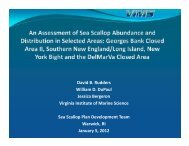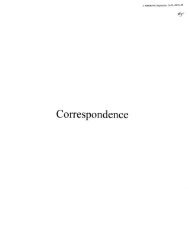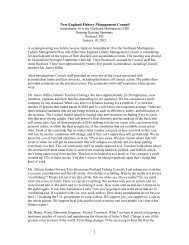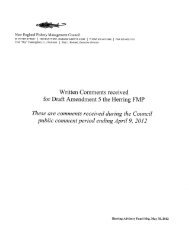Smooth Bottom Net Trawl Fishing Gear Effect on - New England ...
Smooth Bottom Net Trawl Fishing Gear Effect on - New England ...
Smooth Bottom Net Trawl Fishing Gear Effect on - New England ...
You also want an ePaper? Increase the reach of your titles
YUMPU automatically turns print PDFs into web optimized ePapers that Google loves.
NOAA/NMFS Unallied Science Project, Cooperative Agreement NA16FL2264 December 2005<br />
<str<strong>on</strong>g>Smooth</str<strong>on</strong>g> <str<strong>on</strong>g>Bottom</str<strong>on</strong>g> <str<strong>on</strong>g>Net</str<strong>on</strong>g> <str<strong>on</strong>g>Trawl</str<strong>on</strong>g> <str<strong>on</strong>g>Fishing</str<strong>on</strong>g> <str<strong>on</strong>g>Gear</str<strong>on</strong>g> <str<strong>on</strong>g>Effect</str<strong>on</strong>g> <strong>on</strong> the Seabed:<br />
Investigati<strong>on</strong> of Temporal and Cumulative <str<strong>on</strong>g>Effect</str<strong>on</strong>g>s BKAM/CR<br />
3.6 Fisheries Survey Results<br />
3.6.1 <str<strong>on</strong>g>Trawl</str<strong>on</strong>g> Catch Results<br />
A total of fifteen fish species and six invertebrate species were identified from the trawl<br />
catches during the three experimental trawl surveys in early August (pre-chr<strong>on</strong>ic<br />
trawling), and October and November (post-chr<strong>on</strong>ic trawling) at the Mud Hole and Little<br />
Tow sites. Refer to Table 3.6-1 for a list of the fish and invertebrate species caught during<br />
the 2002 trawl study.<br />
To help interpret the catch results from the experimental trawling surveys at Mud Hole<br />
and Little Tow, the data were viewed in several different formats:<br />
• Tables of Catch by Species in kg per Tow (Table 3.6-2);<br />
• Graphs of Overall Catch (Figure 3.6-1), and Average Catch per Tow (Figure 3.6-<br />
2), and Catch Compositi<strong>on</strong> for Mud Hole and Little Tow trawled lanes (Figure<br />
3.6-3);<br />
• Graphs of Densities (weight in kilograms per 1000 square meters) based <strong>on</strong><br />
weight of major demersal species caught and the area swept during each tow<br />
(Figures 3.6-4, 3.6-5, 3.6-6);<br />
• Graphs of Species Density (numbers per 1000 square meters) based <strong>on</strong> numbers<br />
of major species of commercially targeted flounder caught, and the area swept<br />
during each tow (Figure 3.6-7);<br />
• Length frequency distributi<strong>on</strong>s of target species, winter flounder and yellowtail<br />
flounder, at Mud Hole (Figures 3.6-8 and 3.6-9) and Little Tow (Figures 3.6-10<br />
and 3.6-11);<br />
Seas<strong>on</strong>al trends over the study period are clearly seen in the catches sampled during each<br />
of the experimental trawl surveys (Figures 3.6-1 and 3.6-2). In general, flounder and<br />
skate abundance increases in the fall, as the rock crab abundance declines. Spiny dogfish<br />
are found sporadically throughout the study period. Many species are present, such as<br />
Atlantic cod, windowpane flounder, American lobster, and squid, but due to their low<br />
densities, little can be said about their abundance or movements. Focus was placed <strong>on</strong><br />
bottom feeding commercially important demersal finfish, targeted by otter trawling.<br />
Yellowtail flounder and winter flounder were the most closely studied, being predators<br />
<strong>on</strong> benthic infauna and having sufficient numbers to provide an adequate data set.<br />
The entire catch of these flatfish were sorted, weighed and measured. A subset thereof<br />
had their stomachs removed and preserved individually for identificati<strong>on</strong> of their c<strong>on</strong>tents<br />
(see Secti<strong>on</strong> 3.6-2 below).<br />
57







